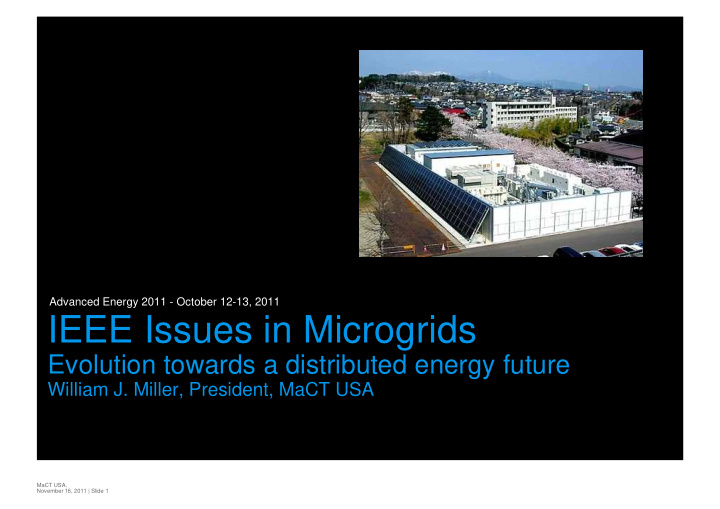



Advanced Energy 2011 - October 12-13, 2011 IEEE Issues in Microgrids Evolution towards a distributed energy future William J. Miller, President, MaCT USA MaCT USA. November 16, 2011 | Slide 1
Slide 2 MaCT USA. November 16, 2011 | Slide 2
Microgrid Automation (Industrial) � OBJECTIVE � Monitor electric power throughout the plant to determine consumption and evaluate how to better manage energy use to save $$$ � CURRENT USAGE 11 MW � COST $ .085/KW � AREAS OF FOCUS � Incoming power from utility at main transformer � Large Consumers: � 1. Finish Mills and support equipment � (3.5 KW & 4.5 KW) � ENERGY MONITORING � 2. ID FAN � Data collection to track consumption � 3. Raw Mill � ENERGY PROTECTION � 4. Kiln Drive (VFD) � Large consuming devices could be isolated � (600 KW) � ENVIRONMENTAL COMPLIANCE � Energy usage goes up energy savings lost MaCT USA. November 16, 2011 | Slide 3
Microgrid Automation Broadband over Power Lines (BPL) MaCT USA. November 16, 2011 | Slide 4
Adaptive Protection Systems Decentralized vs. Centralized � The most significant advantage of a centralized architecture is that local devices do not make decisions, and therefore are simple. The effort of data processing and decision making falls on the central unit based on data received from the local devices. � The main disadvantage of a centralized architecture is well- known, the dependence on the central unit is a single point of failure of the whole adaptive protection system. � Decentralized adaptive protection is possible based on P2P communications, considering standard protocols (e.g. IEC 61850 Goose messages) and Ethernet communications. MaCT USA. November 16, 2011 | Slide 5
Conventional vs. Microgrid’s MaCT USA. November 16, 2011 | Slide 6
Autonomous Microgrid MaCT USA. November 16, 2011 | Slide 7
Autonomous Microgrid’s E&C � COMMUNICATIONS � ENERGY � Peer-to-Peer requires multi-path � Peer-to-Peer Control links for fault tolerance � Distributed local generation � Adapt to changing network � Decentralized adaptive protection conditions with optimal path � Autonomous operation selection � Technology agnostic and protocol � Accommodate legacy systems Independence that can leverage � Accommodate AC or DC use of existing devices � Leverage existing wire/fiber infrastructure � High scalability and secure � Assured Interoperability MaCT USA. November 16, 2011 | Slide 8
Microgrid Automation Challenges � PROTOCOLS - Legacy IP protocols in common use do not use new high speed broadband wireless cellular or the Internet. � TRANSITION - Transition to new protocols is a slow process with investment needed � INTEROPERABILITY - Vendor implementation variants has in many cases resulted � SCALABILITY - Significant cost and complexity � MANAGEMENT - is limited to small scale networks � DATA SHARING - with others including other utilities including disaster response personnel � SECURITY - is more difficult to assure the devices are authorized to participate in the network SOLUTION >> IEEE P1451.1d/XMPP (SOA) >> MaCT USA. November 16, 2011 | Slide 9
XMPP Metadata Approach for Microgrids � Extensible Messaging and Presence Protocol ( XMPP ) is an open-standard communications protocol for message-oriented middleware based on XML (Extensible Markup Language). � The XMPP protocol was developed by the Jabber open- source community in 1999, was originally used as near- real-time extensible instant messaging, presence information, and contact list maintenance. The protocol was designed to be “extensible”, the protocol today also finds application in VoIP and file transfer signaling. � XMPP makes use of an Open Systems approach of development and application, by which anyone may implement an XMPP service and interoperate with other organizations' implementations. The software and many client applications are also open source. � XMPP offers a Service Oriented Architecture (SOA), (i.e. “Cloud Computing”. MaCT USA. November 16, 2011 | Slide 10
Applications Layer Routers (ALR) are Intermediary servers using XMPP � FUNCTIONS: � Enhanced security by blocking unwanted messages, provide authentication to establish that a device is allowed to participate and use of firewalls. � Transcoding, protocol conversion, reformatting, or other functions that enable heterogeneous endpoints to communicate. � Filter or transform content . � Multi-point connections out of point-to-point connections, and allow the endpoints to be shared. � Improved performance in application-dependent ways including caching to assure message delivery. � Improved reliability in application-dependent ways for example by providing automatic retry and retargeting. � Provides capabilities difficult to put into a end device. MaCT USA. November 16, 2011 | Slide 11
IEEE 1451.1d Smart Transducer Standard for Sensor, Actuators, and Devices � The proposed IEEE 1451.1d standard offers a SOA based on XMPP (Extensible Markup and Presence Protocol) � IEEE 1451.0 TEDS (Transducer Electronic Data Sheet) used to validate the characteristics of a end point (sensor, actuator, or device). � Proposed standard will establish a cloud computing architecture for sensor information. � The standard will offer interoperability of protocols and facilitate transport. � The standard will offer assured interoperability, scalability, and security MaCT USA. November 16, 2011 | Slide 12
�������� ����� ����� ��� MaCT USA. November 16, 2011 | Slide 13
IEEE 1451.1d/XMPP BENEFITS Transport Layer Security (TLS) � Provides assurance that the proper credentials are � offered to participate including characteristic identity Advanced Data Sharing � Multiple devices can be shared between multiple � authorized users or applications Distributed Management � Management of all devices via a web browser � Service Broker � Single point reference locally or over the Internet � Directory Services � Indication of online status, device name, � description, etc., Technology Agnostic � Any link offering a connection to the XMPP server � Protocol Independent � XMPP Provides ability to transport any IP protocol, � even proprietary devices can be used Future Proof � Public IP addresses are not needed, the end � devices are effectively transparent using DHCP All devices are registered by a name not an IP � address facilitating ease of use MaCT USA. November 16, 2011 | Slide 14
Recommend
More recommend